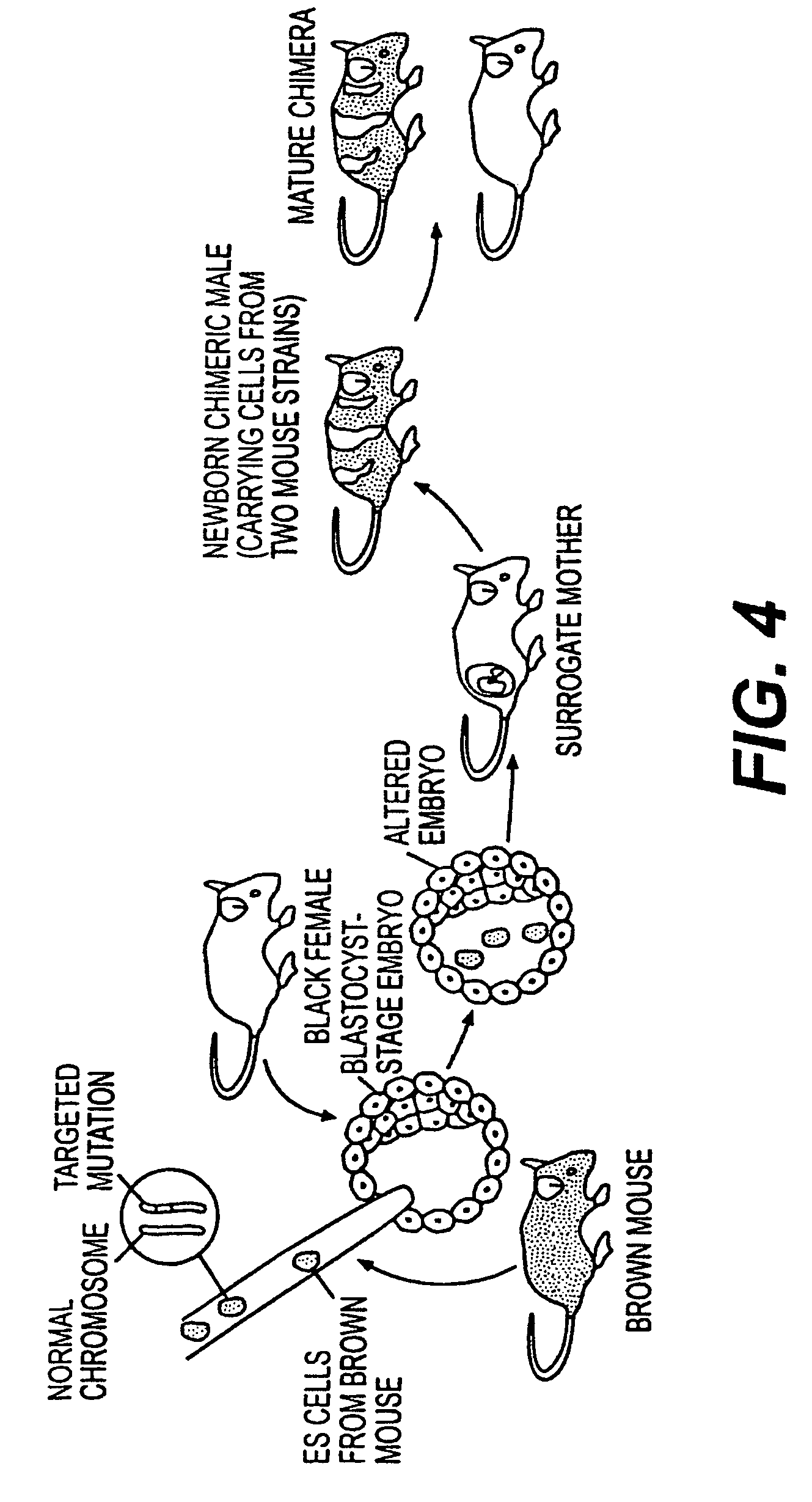Knockout mouse for the tumor suppressor gene ANX7
a tumor suppressor and mouse technology, applied in the field of knockout mouse for the tumor suppressor gene anx7, to achieve the effects of low probability of metastasis, and high probability of metastasis
- Summary
- Abstract
- Description
- Claims
- Application Information
AI Technical Summary
Benefits of technology
Problems solved by technology
Method used
Image
Examples
example i
Production and Characterization of a Transgenic Mouse for the anx7 Gene
[0245]Before beginning the actual production of transgenic mice, the genomic locus for annexin VII (anx7) was characterized. Then, a transgene construct (“targeting vector”) was prepared based on this characterization. This construct carries the necessary elements to facilitate the transgenic animal construction.
[0246]The anx7 genomic locus from a 129SV / CPJ mouse genomic library (Stratagene), which contained 14 exons of the anx7 gene spanning about 34 kb, was screened with mouse anx7 cDNA probe (Zhang-Keck, et al., Biochem. J. 301:835-845.)
[0247]In order to assess which segments of the genomic locus were most suitable for use in the targeting vector, several restriction fragments including three Xba I fragments (1.9, 3.6 and 3.1 kb) and one Xho I fragment (2.0 kb) encompassing this region were subcloned, labeled with 32[P], and tested for the presence of repetitive sequences. Repetitive sequences are undesirable ...
example ii
Spontaneous Tumors in anx7(+ / −) Mice
[0269]A total of 50 heterozygous animals, aged 100-200 days, were subjected to a complete post mortem examination, and 10 proved to have histologically verifiable, macroscopic tumors. These tumors occurred in both male and female animals. The tumors found principally included lymphosarcoma of the thymus, insulinoma, and hepatocellular carcinoma. No instance of defined tumors was detected in the control animals.
[0270]In a second set of 50 heterozygotes, aged ca. 1 year old, a vastly increased tumor incidence of ca. 50% was detected. In the older animals the principal tumors were also lymphosarcoma of the thymus and hepatocellular carcinoma. In some instances more than one type of tumor was detected in the same animal. In addition, there were several instances of dysplastic thymic organization in otherwise “normal” mutant animals.
[0271]Lymphosarcoma of the thymus is a frequently occurring tumor in these mutants. One particularly interestingly exampl...
example iii
Determination of Levels of ANX7 Protein in Tissues from anx7(+ / −) Mouse.
[0279]As noted above, certain organs (e.g., heart and pancreatic islets) in the anx7 (+ / −) mouse exhibit organomegaly. Tissues from anx7 (+ / −) and control mice were harvested, frozen on dry ice, and then homogenized in boiling SDS buffer, and then assessed for ANX7 protein. Aliquots containing identical amounts of protein were separated by SDS-PAGE, transblotted to nitrocellulose, and ANX7 visualized using rabbit anti-ANX7 primary antibody, HRP-conjugated secondary antibody, and ECL detection on X-Ray film.
[0280]As shown in FIG. 13, ANX7 levels in the pancreas of male anx7(+ / −) mice contain 20-30% of the ANX7 levels in pancreatic tissue from control animals. Heart tissue was also run in parallel, with similar results. ANX7 from heart has a tissue-specific cassette exon edited into the higher molecular weight edited product.
[0281]ANX7 levels appear to be much lower in mutant than in control pancreas, heart, and o...
PUM
| Property | Measurement | Unit |
|---|---|---|
| diameter | aaaaa | aaaaa |
| molar ratio | aaaaa | aaaaa |
| volume | aaaaa | aaaaa |
Abstract
Description
Claims
Application Information
 Login to View More
Login to View More - R&D
- Intellectual Property
- Life Sciences
- Materials
- Tech Scout
- Unparalleled Data Quality
- Higher Quality Content
- 60% Fewer Hallucinations
Browse by: Latest US Patents, China's latest patents, Technical Efficacy Thesaurus, Application Domain, Technology Topic, Popular Technical Reports.
© 2025 PatSnap. All rights reserved.Legal|Privacy policy|Modern Slavery Act Transparency Statement|Sitemap|About US| Contact US: help@patsnap.com



